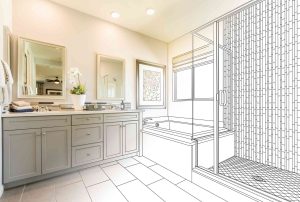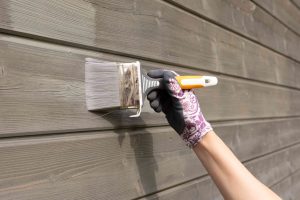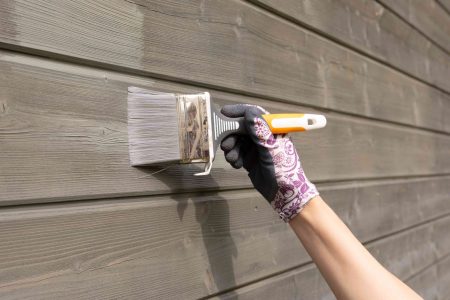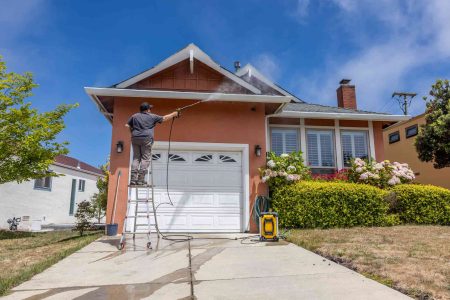Even a hardy material like brick needs occasional maintenance. Brick’s water sealant should be refreshed when it wears down and efflorescence needs to be removed. Damaged bricks must be repaired or replaced.
Another important maintenance task is a mortar joint repair project called tuckpointing. Tuckpointing is an inexpensive though time-intensive project that cleans up mortar lines and preserves the entire brick system for the long term.
What Is Tuckpointing?
Brick can last for centuries. But mortar—the mineral bond between bricks—does not last this long. Softer than brick, mortar is the weakest part of the system and will deteriorate to the point of repair after 25 to 30 years. Poor conditions accelerate the decay.
Tuckpointing (or repointing) removes damaged or deteriorated mortar to a consistent depth. New mortar is then forced into the joints between the bricks either with a pointing trowel or a mortar gun. A mortar gun looks much like a caulking gun. The gun’s empty tube is manually filled with mortar and the mortar is dispensed by squeezing the mortar gun’s handle.
Finally, a rounded pointing tool pushes the mortar farther into the joints, while also smoothing and rounding the mortar.
Tuckpointing vs. Repointing vs. Pointing
Tuckpointing brick and repointing brick are two names for the same procedure—with one minor exception. Pointing brick is different from tuckpointing and repointing.
- Tuckpointing and repointing: Both are names for the same process of removing defective mortar from the joints between bricks and replacing it with new mortar. This is a retroactive procedure done for existing brick.
- Pointing: Pointing is the process of filling mortar joints between bricks during installation. Pointing brick is done when the brick is initially being laid.
When to Tuckpoint Brick Mortar
Tuckpointing brick mortar should be done about every 25 to 30 years, or sooner on an as-needed basis. Brick located in humid or wet areas may require more frequent tuckpointing. Conditions that warrant tuckpointing include:
- Mortar has eroded more than 1/4-inch
- Mortar crumbling from the joints
- Significant voids in the mortar
- Hairline cracks in the mortar
- Cracks between the brick and mortar
- Vines growing through the bricks or mortar
DIY vs. Professional Mason Tuckpointing
Mortar joints can comprise hundreds of linear feet in a brick wall, making tuckpointing a labor-intensive project. Plus, using a power tool to clear mortar from joints, especially perpendicular joints, poses the risk of cutting into the brick. Partially tuckpointing a brick surface requires expert color-matching between the new mortar and the old mortar.
Have a qualified mason tuckpoint the brick joints if you feel you aren’t able to cleanly remove the mortar without damage and tuckpoint all of the joints.
Materials and Tools for Tuckpointing
Materials
- Type N ready-mix mortar for pointing
- Plastic sheeting
Tools
- Angle grinder, 4-1/2-inch
- Mortar removal blade (4-1/2-inch) for angle grinders
- Wheeled raking tool
- Toothed masonry hand chisel
- Pointing trowel, 3/8-inch
- Mortar gun with flat and angled nozzles
- Hammer
- 5-gallon bucket
- Soft brush
- Shop vacuum
- Breathing, eye, and hearing protection
How to Tuckpoint
-
Protect Work Site
Cover sensitive areas or shrubbery with plastic sheeting.
-
Determine the Uniform Depth
Before you start removing mortar, decide on the uniform depth. With a straight-edge ruler, measure the width of the brick joints. The depth of mortar removal should be two times the mortar joint thickness or as deep as you need to go to reach solid mortar. Add a strip of painter’s tape to the straight edge at that depth.
-
Remove Mortar From the Horizontal Joints
Grinding brick mortar produces heavy silica dust, so wear breathing, eye, and hearing protection.
Fit the tuckpoint blade on the angle grinder. Work from the top to the bottom to avoid adding mortar debris to cleaned-out joints. Remove the mortar on the horizontal (also called bed) joints with the grinder. A 1/4-inch-thick grinder tuckpoint blade is the right size to fit in 3/8-inch mortar joints, with extra working room on the top and bottom.
-
Remove Mortar From the Vertical Joints
Clear mortar from the vertical (also called perpendicular) joints. Like the horizontal joints, start at the top and work toward the bottom. Clearing the perpendicular joints with the angle grinder and tuckpoint blade is difficult, as it risks cutting into surrounding brick courses. Both the wheeled raking tool and the toothed masonry chisel fit neatly into that tight space and are easier to control than the grinder.
-
Clean the Brick Joints
Use a stiff brush and shop vacuum to clean all debris from the brick joints.
-
Mix the Mortar
Mix the mortar with water in the five-gallon bucket to a smooth, workable consistency. Be sure to use type N mortar.
-
Fill the Mortar Gun
Use the mortar gun’s scoop to transfer mortar from the bucket to the empty tube.
-
Add Mortar to the Joints
With the mortar gun, squeeze mortar into the brick joints. Start with the long, continuous horizontal bed runs. Then, go back and fill in each of the shorter vertical or perpendicular joints. Make sure that the mortar is forced all of the way to the back of the joint.
-
Let the Mortar Rest
Leave the mortar for about 30 to 45 minutes to partially dry. Test by pressing the mortar with your finger. If your finger does not leave a depression, the mortar is ready for repointing. Do not let the mortar completely dry out.
-
Repoint the Vertical Joints
Starting with the vertical perpendicular sections, press the pointing tool flat into the mortar. Slide the tool up and down to smooth and compress the mortar. Do this for all vertical joints.
-
Repoint the Horizontal Joints
Follow immediately by repointing the horizontal bed mortar courses.
-
Clean the Vertical Joints
Return to the vertical perpendiculars and use the pointing tool to clean them up.
-
Brush Away Excess Mortar
With a soft-bristled brush, brush away excess mortar from the face of the brick. Go easy to avoid digging into the newly repointed mortar between the bricks.
-
What does tuckpointing do?
Tuckpointing removes old or crumbled mortar between the bricks and fills the open joints with new mortar.
-
What is the difference between tuckpointing and repointing?
For the most part, there is no difference between tuckpointing and repointing. Both terms mean the same thing. Tuckpointing may refer to a process that creates the look of thin mortar lines, though this usage is rare.
-
What is the difference between pointing and tuckpointing?
Pointing brick is the process of adding mortar to brick joints when the brick is initially installed. Tuckpointing (or repointing) is the process of removing poor mortar from bricks and replacing it—usually, after the brick has been in place for years.
-
What happens if you don’t do tuckpointing?
If you don’t do tuckpointing, water will begin to enter the wall between the bricks. Water infiltration will speed up the decay of the mortar.
-
How often should tuckpointing be done?
Tuckpointing should be done every 25 to 30 years or when the brick mortar is crumbling or cracking.
-
Why is it called tuckpointing?
Tuckpointing refers to the need to tightly push or tuck the mortar into the brick joints. A pointing trowel is used to compact or tuck the mortar between the bricks.
Read the full article here














